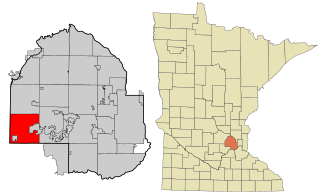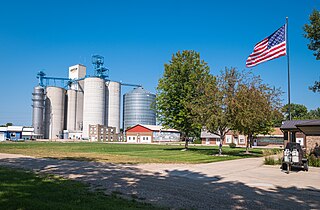
Eagle Lake is in Blue Earth County, Minnesota, United States. The population was 3,278 at the 2020 census. It is part of the Mankato-North Mankato Metropolitan Statistical Area.

Lake Shore is a city in Cass County, Minnesota, United States. The population was 1,056 at the 2020 census. It is part of the Brainerd Micropolitan Statistical Area.

Chisago City is a city in Chisago County, Minnesota, United States, approximately 35 miles northeast of downtown Minneapolis–Saint Paul. The population was 4,967 at the 2010 census.

Breezy Point is a city in Crow Wing County, Minnesota, United States. It is part of the Brainerd Micropolitan Statistical Area. The population was 2,346 at the 2010 census.

Twin Lakes is a city in Freeborn County, Minnesota, United States, near Albert Lea. The population was 134 at the 2020 census.

Minnetrista is a city in Hennepin County, Minnesota, United States. It is located about 23 miles (37 km) west of Minneapolis. Although it is part of the Minneapolis–Saint Paul metropolitan area, the largely rural Minnetrista has agricultural activity involving corn, soybeans, hay, and horses. In addition to farmland and woods, the city is home to several lakes, including part of Lake Minnetonka, the state's ninth-biggest. The city's population was 6,384 at the 2010 census. Minnetrista's name originates in the Dakota language, in which minne means "water" and trista means "crooked".

Heron Lake is a city in Jackson County, Minnesota, United States. The population was 698 at the 2010 census.

Dexter is a city in Dexter Township, Mower County, Minnesota, United States. The population was 341 at the 2010 census.

Clitherall is a city in Otter Tail County, Minnesota, United States. The population was 62 at the 2020 census.

Vergas is a city in northern Otter Tail County, Minnesota, United States. The population was 348 at the 2020 census.

Sturgeon Lake is a city in Pine County, Minnesota, United States. The population was 439 at the 2010 census.

Winger is a city in Polk County, Minnesota, United States. It is part of the Grand Forks, ND-MN Metropolitan Statistical Area. The population was 174 at the 2020 census.

Arnold is a former census-designated place (CDP), which was located in Rice Lake, Saint Louis County, Minnesota, United States. The population was 2,960 at the 2010 census. The census-designated place of Arnold was located entirely within the former Rice Lake Township, adjacent to the north side of the city of Duluth. Rice Lake Township was incorporated as the city of Rice Lake on October 22, 2015, thus rendering the census-designated place of Arnold to no longer exist.

Babbitt is a city in Saint Louis County, Minnesota, United States. As of the 2020 census, the city had a population of 1,397.

Cook is a city in Saint Louis County, Minnesota, United States. The population was 515 at the 2010 census.

Hoyt Lakes is a city in Saint Louis County, Minnesota. The population was 2,017 at the time of the 2010 census.

Grant is a city in Washington County, Minnesota, and a suburb of St. Paul. The population was 4,096 at the time of the 2010 census.

Federal Dam is a city in Cass County, Minnesota, United States, near Leech Lake. The population was 110 at the 2010 census. It is part of the Brainerd Micropolitan Statistical Area.

Battle Lake is a city in Otter Tail County, Minnesota, United States. The population was 857 according to the 2020 census.

Minnesota Lake is a city in Blue Earth and Faribault counties in the State of Minnesota. The population was 661 at the 2020 census. The bulk of the city is in Faribault County; a small part extends into Blue Earth County.






















